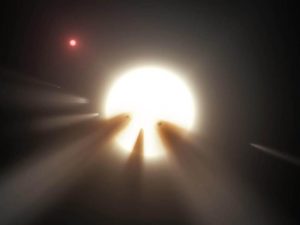The “Alien Megastructure” Star Is Acting Up Again
A large dip in the star’s brightness suggests something massive is orbiting the fiery body.

Artist’s impression of a comet swarm around Tabby’s Star (NASA/JPL-Caltech). Image: http://www.smithsonianmag.com/smart-news/alien-megastructure-star-acting-again-180963411/?utm_source=keywee-facebook.com&utm_medium=socialmedia&utm_campaign=keywee&kwp_0=433816&kwp_4=1619210&kwp_1=698201
Over the weekend a call went out to astronomers to point their telescopes toward star KIC 8462852, which is also known as Tabby’s Star or the “Alien Megastructure” star. That’s because researchers suspected the star was beginning to dim—something astronomers have been waiting to observe since 2015, reports Sarah Fecht at Popular Science.
Dips in brightness of stars usually represent some type of body—like a planet—orbiting a distant star. Since Kepler Spacecraft’s launch in 2009, the mobile observatory trained its sights on the brightness of stars to catch these blips of light, reports Marina Koren at The Atlantic. But after the Kepler data was released to the public in 2011, volunteers discovered that Tabby’s star was different than the 150,000 other stars in the survey. When it dimmed, its brightness dropped by 20 percent (for reference, a Jupiter-sized planet would drop the brightness by around one percent), reports Fecht. Something massive must be circling Tabby’s star.
Researchers have been eagerly waiting for the brightness on Tabby’s star to dip again so they can get closer readings. And they’re finally getting their chance. As Loren Grush reports for The Verge, last Thursday night, astronomer Matt Muterspaugh at Tennessee State University who has been watching the star, noticed its brightness was dipping. On Friday, when it dipped further, he put the call out to the astronomy community. “As far as I can tell, every telescope that can look at it right now is looking at it right now,” he tells Grush.
The cause of that drop in dimness has long been debated. Some researchers have suggested that something massive is orbiting the star, such as a cluster of comets. In 2015, astronomer Jason Wright at Penn State suggested that the dip could be caused by a Dyson Sphere—a hypothetical alien megastructure proposed physicist Freeman Dyson in 1960. A Dyson Sphere is a massive solar-power collecting structure that Dyson suggested could have been created by advanced civilizations that, during its construction, would orbit its sun and occasionally block out its light. Dyson suggested astronomers look for these spheres to help find alien civilizations.
But before you get riled up: aliens are on the bottom of the list of plausible causes for natural phenomena.
These latest observations, however, could help researchers finally come to an answer. As Grush reports, if the cause is a comet storm, then the comets will orbit very close to the star, heating them up enough to show up in infrared images. If it is an alien megastructure, well, we’re not sure what the would look like. “That theory is still a valid one,” Muterspaugh tells Grush. “We would really hate to go to that, because that’s a pretty major thing. It’d be awesome of course, but as scientists we’re hoping there’s a natural explanation.”
Earlier this year, a team of astronomers came up with another compelling idea. They suggest that Tabby’s star ate one of its own planets sometime in the last ten millennia, an event that caused the star to shine more brightly. And now, the star is dimming down as it digests its cosmic lunch.
